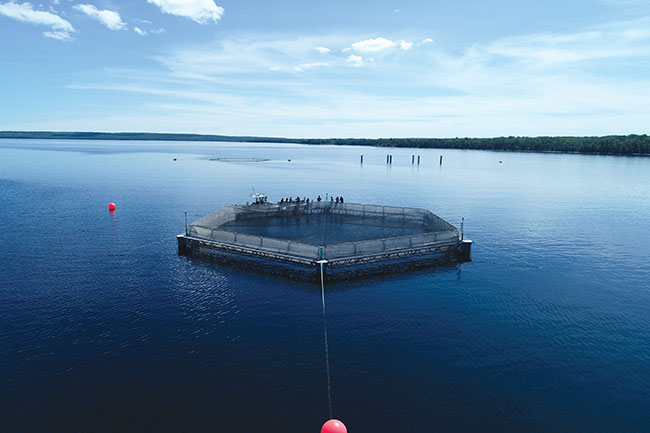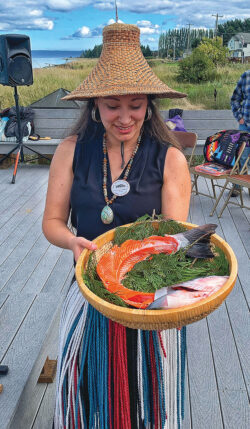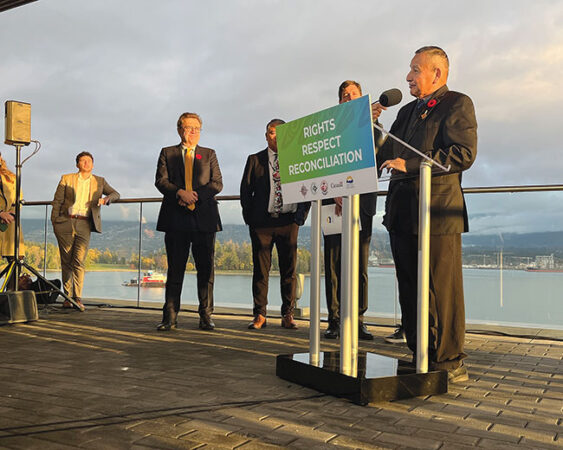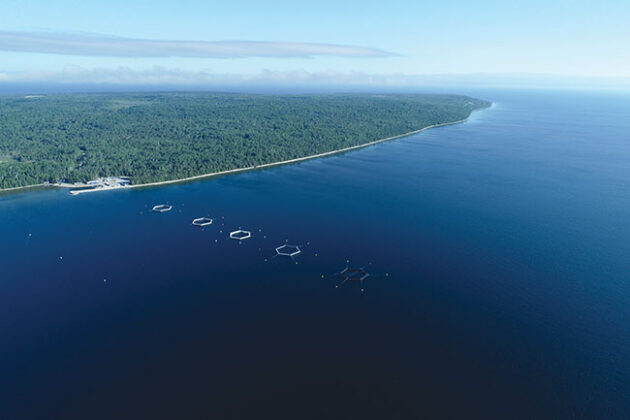
Ingenuity and insult
January 16, 2024
By Lynn Fantom
Perspectives on Indigenous aquaculture in North America
 Springhills Fish Farm in Manitoulin Island, Ont., Canada (Photo: Springhills Fish)
Springhills Fish Farm in Manitoulin Island, Ont., Canada (Photo: Springhills Fish) Some 3,500 years ago, Indigenous people of the Pacific Northwest created “clam gardens” by building rock walls at the low tide mark with flattened terraces landward. They varied construction style based on beach geology and ecology but consistently chose areas with strong tides that would deposit pulverized shell and sediment in the terraces. This design produced clam yields two to four times greater than open beaches, according to scientists. And by keeping clams cooler, the walled structures also made clams safer to eat.
The “ingenuity of clam garden engineers,” as a researcher wrote, is just one example of Indigenous aquaculture being studied and revived today. As cross-cultural awareness overall has grown in both Canada and America in recent decades, an appreciation of Native communities’ expertise has spilled over into aquaculture. At the same time, political clashes regarding aquaculture, especially in Washington state and British Columbia, have increasingly thwarted understanding of how these techniques can contribute to a new sustainable food system.
“Without such knowledge of past cultural advances, societies worldwide will lose one of their greatest opportunities for more socially and environmentally sound forms of food production. The aquaculture profession will continue to limp along… due to the tiresome constraints repeated over and over about a lack of ‘social license’ for aquaculture,” wrote Barry Antonio Costa-Pierce last year in a paper entitled “The Anthropology of Aquaculture.”
Still, progress is now playing out on North America’s coasts, as well as the Great Lakes in between, where Native communities are involved in farming finfish, shellfish, and seaweed for economic diversity and cultural preservation—as well as food. As Native American activist Winona LaDuke said a few years ago, “You can’t say you’re sovereign if you can’t feed yourself.”
But sometimes, that path forward has been ambushed by politics or obscured by complex technology. During a 2022 panel called “Indigenous Perspectives” at the Washington Seaweed Knowledge Symposium, Loni Grinnell-Greninger said that, in her role as vice chair of the Jamestown S’Klallam Tribe, she relies on in-house experts to help “translate Western science methods, tools, and research into our Indigenous Jamestown perspective and then figure out how to beautifully blend them together so that I am stewarding the lands as I’m supposed to, as the Creator told me to, thousands of generations ago.”
Political obstacles in Washington
Just a month before that conference, Washington State Commissioner of Public Lands Hilary Franz announced an executive order banning commercial finfish net pen aquaculture in state-owned aquatic lands. In a much-watched move, Jamestown S’Klallam Tribe sued. But almost a year later, a state superior court judge ruled in November that the order is “an inward-facing directive to department leadership and all staff to develop agency rules, policies, and procedures to prohibit commercial net pen aquaculture.” Until that occurs, the order “lacks legal operative effect.”

Loni Grinnell-Greninger celebrating a salmon ceremony with the S’Klallam Tribe.
Photo: Joseph Price
Still, the public statements by Commissioner Franz had “a chilling effect on the entire aquaculture sector,” according to a press release from the Northwest Aquaculture Alliance, which joined Jamestown in the lawsuit. And now for the upcoming year, industry watchers contend Franz will likely block new farm leases as she wraps up her tenure as public lands commissioner.
This past November, Franz announced her bid to represent Washington’s 6th Congressional District, with the endorsement of incumbent U.S. Rep. Derek Kilmer, who announced he won’t seek a seventh term.
However, in an email statement, CEO and Chairman W. Ron Allen said, “The Jamestown S’Klallam Tribe is moving forward with our plan to rear native steelhead trout and sablefish in Port Angeles on the Salish Sea. It is unconscionable that Commissioner Hilary Franz continues to illegally block our tribe from producing the traditional food our tribal citizens need to sustain our cultural way of life, and violates our treaty rights within our own fishery territory.”
The tribe’s commitment to aquaculture stands strong. Working through its subsidiary, Jamestown Seafood, it already has a successful shellfish seed operation. In addition, it grows, harvests, processes and ships both oysters and geoduck. At the same time, it harvests wild salmon and honors that tradition.
Mixed messages in B.C.
First Nations to the north in British Columbia (B.C.) have divergent views toward aquaculture.
In early November, the First Nations Wild Salmon Alliance convened in Ottawa to lobby the federal government to proceed with plans to transition away from net pen salmon farms in B.C. waters by 2025. The organization contends that net pens allow diseases and parasites to spread to wild salmon. Among those with whom the chiefs met was Fisheries Minister Diane Lebouthillier, who was appointed last July.
Three weeks later, the Coalition of First Nations for Finfish Stewardship (FNFFS), which advocates for the right of Native title holders to decide if, when, and how to operate finfish aquaculture in their traditional waters, appeared on Parliament Hill calling for “the immediate renewal of long-term salmon farm licensing (nine years) for investment security and growth,” according to a press release. The coalition delivered to Lebouthillier a “new, positive plan” to solve what’s been a divisive issue in B.C.,” said spokesperson, Dallas Smith. Among its components are greater federal government investment in Indigenous-led aquaculture science and technology and creation of a new Indigenous Centre for Aquatic Health Sciences in Campbell River.
The FNFFS is also calling for the completion of social and economic impact studies related to aquaculture. Looking at The Tlowitsis Nation’s decade-long relationship with Grieg Seafood, for example, shows just how multi-dimensional those impacts are. Tribal ‘guardians’ monitor the farms at three sites in the traditional Tlowitsis territory of Clio Channel. Other members are Grieg employees. The tribe also holds a contract with Grieg for net cleaning.

Government of Canada, British Columbia and the First Nations Leadership Council signed a historic tripartite nature conservation framework agreement.
photo: Union of British Columbia Indian Chiefs
Tribal stewardship
While some conduct commercial aquaculture themselves in independent or joint ventures, Tribes also act in governing capacities, with departments of natural resources of their own.
At the federal level in the U.S., for example, it is policy for the U.S. Army Corps of Engineers to involve tribes collaboratively, before and throughout decision-making. Blair Paul of the Skokomish Department of Natural Resources in Washington State explained that “the Army Corps of Engineers sends us the permit for review to see if we are going to object.” A reason might be interference with fishing rights. “If that did occur, the permit would be on hold until the proponent of the project worked it out with us and we released that hold,” he said.
Some aquaculture companies collaborate directly with tribes. Jeff Dickison of the Department of Natural Resources of the Squaxin Island Tribe, known as “People of the Water,” has worked closely with Taylor Shellfish Farms, for example. When Taylor was proposing a large floating shellfish nursery for Oakland Bay in Washington, it consulted with the tribe early on and designed a system that could be towed away to accommodate seasonal tribal fisheries.
In Ontario, farmers seeking licenses for projects in Lake Huron have two options: a Government of Ontario license or one from the First Nation. But even if it’s an Ontario license, consultation occurs with the First Nation.
“There is a huge precedent that the First Nations oversee their fisheries and water resources. They are the ultimate stewards and authorities in their territories,” said RJ Taylor, the current managing director of the Ontario Aquaculture Association (OAA) who is himself a second-generation farmer and co-owner of Springhills Fish.
Today, in that province, there are almost a dozen net pen sites in operation, the vast majority of which is in partnership with Indigenous communities which have issued licenses and have joint equity.

Springhills Fish Farm’s net pens in Lake Huron, Ont. Photo: Springhills Fish
Projects today and in future
Waubetek Business Development Corporation, which describes itself as Aboriginal-owned and controlled, is a member of the OAA that provides business financing and consulting to First Nation communities and entrepreneurs throughout northeastern Ontario.
“Waubetek” means “the future” in the Ojibwe language, and the organization sees aquaculture’s value increasing, now and in years to come. Two aquaculture experts on staff are working with some three dozen First Nation groups in Ontario, helping to identify opportunities, advising on business plans, and conducting training. Projects now range from a small restocking program for walleye to planning a recirculating aquaculture farm for whitefish.
Eastward in Newfoundland and Labrador (NL), the Miawpukek First Nation (MFN), which had agreed to investigate breeding lumpfish for use by Mowi, is exploring a partnership with Marbase, backed by Norwegian aquaculture expert Bjorn Apeland. The tribe would hold a 51 percent equity position in a joint hatchery to raise both lumpfish and wolffish, according to Marbase CEO Paul Antle.
“I have personally known Chief Mi’sel Joe for almost 30 years and was delighted that we could consider a project together,” Antle said, adding that MFN would bring “relationships with the aquaculture sector, existing knowhow, a sustainable aquaculture philosophy, capital, and social/environmental alignment.”
Mutual learning
Back in Ontario, RJ Taylor talked about his personal experiences raising trout and steelhead with Sheshegwaning First Nation. The tribe introduced him to the tradition of both opening and closing ceremonies each season.
On the final day of the harvest, he said, members of the tribe and Springhills convened down at the shore, along with their families, from grandparents to kids. “Everyone stood in a circle on a very cold day in January and talked about why they’re grateful for the farm,” said Taylor.
One of the elders had requested tamarack wood to burn at the ceremony: the event could help introduce its youth to tribal customs. Tamarack grows from Labrador to West Virginia, across southern Canada to northern British Columbia and Alaska. Although a destructive insect reduced the population during the early 20th century, these trees—which have many traditional uses among Native peoples—thrive today.
RJ Taylor was able to find tamarack for the ceremony that day, carrying on a Native tradition and creating a new one for his company.
Advertisement
- American Unagi receives $1.5M investment towards expansion
- Massive fire damages crab-landing facility in Ilwaco Landing





